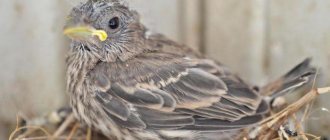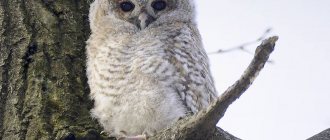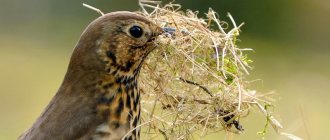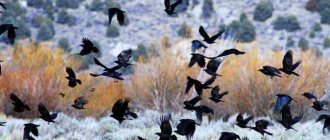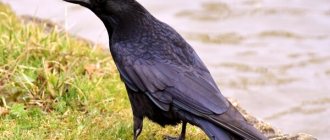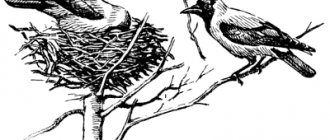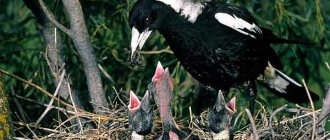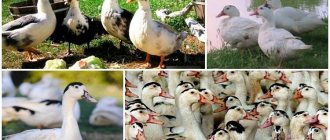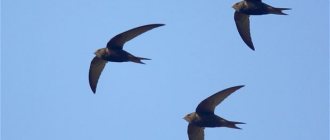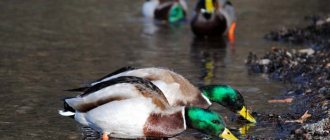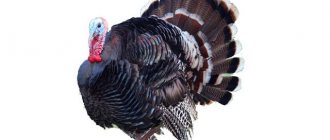This beautiful and proud bird can truly become a true friend. Her intelligence exceeds that of a dog or cat and is comparable to the abilities of a horse or dolphin. A raven can, for example, use a stick to get food placed next to the cage. It will also strengthen dry bread by soaking it in water. This bird is capable of throwing stones into a narrow vase until water becomes available for it to drink.
How not to confuse raven and crow chicks?
However, instead of the expected raven, you may end up with a bird from the same family with a similar name - a crow. How to distinguish a raven chick from a crow? The raven is larger and has a wedge-shaped tail (the crow has a flat tail). The plumage on a raven's crop is tousled, while that of a crow is smooth. The color of a crow chick is the same as that of an adult bird. The crow “croaks”, articulating correctly, but the raven makes a different sound - it clicks.
They also differ from each other purely in character: like a devoted knight and a pathetic thief. It is no coincidence that we used the word “knight” in the context of the name of the bird “raven”, because the British have been honoring and maintaining six ravens of the Tower Fortress for many centuries, since the time of King Charles II.
How to avoid misunderstandings by unexpectedly raising a crow? The answer is simple: either take a raven chick from a nursery, or buy from a seller with a good reputation.
We are far from thinking that in May you will be able to personally get into the thicket of the forest and pick up a three-week-old chick from a raven’s nest at a great height. Moreover, even if you accomplish such a feat, you will inevitably be attacked by his parents. And an adult raven, having accelerated in flight, as is known, with a blow of its beak may well kill a fox. Obviously, it is wiser for the future owner of the chick to avoid such injuries.
Therefore, we direct you to purchase poultry based on the ad. The market price of a fledgling raven in Moscow markets is $100.
Competent diet of crows at home
The diet of birds in the wild is very different from home breeding, because few owners will feed their birds carrion. The list of products that should be given to a crow at home is quite long:
- meat: beef, chicken, mice, rabbits. It is worth noting that this item is mandatory in the diet of any crow;
- porridge: buckwheat and oatmeal;
- cottage cheese, boiled eggs;
- apples, carrots, berries;
- baby food - for chicks;
- premium dog food.
Although they are considered omnivorous, there are some restrictions. She is prohibited from consuming the following foods:
- pork is too fatty for the poultry diet;
- tomatoes;
- potato;
- citrus;
- sweets and savory foods;
- black bread.
Due to such an abundant diet, bird droppings have a peculiar smell, so the room where the raven lives should be well ventilated. If you ask an ornithologist whether it is possible to tame a raven, the answer will be ambiguous. These wild birds are capricious, so you can expect many surprises from them. It should be expected that the found feathered friend may be sick
A raven seen in a dream is a harbinger of trouble, trouble, failure and even death. Many people associate their grief with this bird, perhaps because of its black color, or perhaps because crows are an integral part of any cemetery and, according to legends that have reached us, peck out the eyes of the dead. There are many folk superstitions associated with this deadly bird. Perhaps these signs, deposited in your subconscious, evoked the image of a raven in a dream: “A raven croaks - to a dead man”, “Whoever sings in the forest and sees a raven will stumble upon a wolf”, “A raven croaks at a church - to a dead man in the village; croaks on the ground - to the dead man in the yard”, “Through which the yard the raven flew, cawing, there will be a dead man there.”
Watching a raven leave its nest in a dream is a harbinger that you should abandon the business you have started, because it will only bring troubles and misfortunes.
Seeing a raven sitting on a tall tree in a dream means that your troubles will not end soon, and therefore in real life you should gain strength and overcome all life’s adversities with dignity.
If in a dream a raven looks at you intently, then you will become an involuntary witness to a sad incident.
If you dreamed that a raven was circling above your head, then such a dream prophesies trouble. If a raven circles above you screaming, then this is a fatal symbol, indicating a serious illness or death of a person close to you.
Destroying crow's nests in a dream is a sign that you should abandon the business you have started, because it will bring great misfortune. Perhaps such a dream indicates that, unexpectedly for yourself, you will cause the death of a person close to you.
If in a dream you saw a raven carrying a snake in its paws, then such a dream suggests that soon you will have the opportunity to make what you think is a valuable acquisition, which will cause you a lot of trouble.
If you dreamed of a loudly croaking raven, then the dream warns that in real life you should be very careful in communicating with other people, because with your sometimes very harsh words and unfounded remarks you greatly offend others, as a result of which there is a possibility that Soon you will be completely without friends. So this dream is a clear confirmation of one simple truth: before you say something, you need to think several times.
Interpretation of dreams from the Ancient Dream Book
Subscribe to the Dream Interpretation channel!
And other types of poultry, some people prefer to have rather unusual pets. Some - by chance, some - making a conscious choice, but, one way or another, one fine day... a crow appears in your house.
How to care for this bird? Is it suitable for home use? What to feed a crow? We invite you to find out the answers to these questions from our publication...
At what age is a raven chick adopted?
The raven is immensely devoted to only one person, whom he considers the owner, but he simply resigns himself to other cohabitants. He does not like small children and pets, being jealous of the owner.
For taming, it is best to take a bird that is two to three weeks old. Females are easier to train and less impulsive. We recommend them to beginners. A specialist distinguishes them at this age solely by external signs. Classes are conducted according to the classical method for birds of prey. If you buy raven chicks from a breeder, the cutoff age for purchase is 2-3 months of age.
After six months, the chick is identical in size to the adult bird. At this age, he is already difficult to train. And an adult raven, starting from the age of one year, is no longer suitable for living at home. By the way, a bird is considered to be fully formed only at the age of three.
A raven chick (you can see a photo of a three-week-old fledgling in the illustration) becomes a poultry thanks to persistent taming and training. Unfortunately, most people who decide to raise this bird act rashly, believing that the chick of a proud bird will turn out to be a stylized likeness of a parrot.
Crow from the street: how to tame him?
For those who found an abandoned crow and decided to take it home, there is good news - taming such a baby will be easy and simple. He will be obedient, tame and will easily do everything that his beloved owner will require of him. But this idyll will not last forever. In just a couple of years, there will come a time when the bird will demand freedom and at any opportune moment, without hesitation, will fly away even from the most comfortable home. Nature takes its toll, and it is impossible to resist it.
But for those who brought home an adult, you should not count on acquiring a best friend. It is impossible to train such a bird; its only thoughts will be to escape.
If all these difficulties seem trivial, you can safely get yourself a crow. The only recommendations would be advice - buy a bird at the age of 3 months from special breeders, then there is a chance to make something useful out of it. But older birds are no longer amenable to training, which means that getting a pet instead only increases the problem. It is difficult to answer the question - how to tame a crow.
It is very important to take care of and feed the crow yourself. Otherwise, she will not understand who her owner is and will be naughty and wild. It is also recommended to have only one individual, otherwise the birds will live their own lives and will not pay any attention to the owner.
What should the owner of a raven chick be prepared for?
A raven is two in one: a predator and a talking, intelligent, loving bird. But if you want to become its owner, it is not enough for the raven chick to formally settle in your home. The owner should love him actively, tinker with him (i.e. teach, train, communicate) every day for two to three hours a day.
Raven is a friend. If you manage to train him, he will give you a lot of positivity, but also ask a lot from you. For this friendship, you, as the owner, will have to sacrifice... at least one room in the apartment. Rest assured, after a year of keeping a crow in it, it will be prepared by the bird for repair.
A raven and a cage are incompatible things: an impulsive bird breaks feathers in it. If it is not possible to allocate a “private room” to the bird, you can equip an aviary (at least 2 x 2 m). It should include a container for bathing birds and toys.
Mating season and birth of chicks
The mating season (possibly 2-5 years of the bird’s life) begins with joint flights, games and somersaults in the air. Nesting time is in the spring months. The pair builds a nest together in parks, forests, near human habitation or construction sites. It consists of branches, stems, wire with a bedding of feathers. The female lays up to 4-6 turquoise eggs, and incubates them herself for 20-25 days. The male takes care of the food of his chosen one.
A newborn crow is practically devoid of feathers and needs round-the-clock care. Adults bring food, taking turns going in searches. The chicks do not see anything around for a long time, and the process of eating can take more than an hour and a half.
Over time, the offspring of hooded crows develop brownish plumage. At the end of May - beginning of June they learn to fly independently. In mid-June, they can already forage for food and fly far from the nest. Adults help the grown-up crows get used to the outside world for about two more weeks.
When is it not advisable to have a raven?
It is contraindicated to have this bird in families with small children! It is not advisable to have other animals (dogs, cats) in the house. An adult raven is a bird with character. He will be jealous of their owner and even attack their “competitors.”
It is not enough for the owner of the bird to proceed solely from mercy when thinking about how to hatch a raven chick. It is equally important to ask yourself the second question: “Will I be able to raise a noble tame raven?”
It is not recommended to keep a bird at home without devoting time to training it. In this case, the raven does not feel the owner and begins to compete in its own way with the housemates, turning into a real punishment, practicing all sorts of dirty tricks:
- he will consider not only his room, but the entire apartment as his territory (torn documents, torn wallpaper, cornices, baseboards, household utensils, furniture);
- he will not be accustomed to relieve himself locally;
- he will attack your guests.
Releasing a bird that has not been trained by adult crows “into the wild” is a sure way to kill it. A domestic raven dies in the wild.
If, after reading our warning, you remained at your desire and continue to solve the puzzle “How to find a raven chick?”, then the following information is for you.
What to do if you find a chick?
If you find a chick lying near a window, or on a glass surface, and the chick cannot sit independently and does not orient itself in space (does not try to run away from you), then perhaps the fledgling, not yet able to fly, crashed into the glass surface. It is not uncommon for fledglings to be hit by vehicles, and if the chick remains alive, it requires immediate examination by a veterinarian. In all other cases, just pass by, there is no danger for the chicks.
This is a jay chick. He is not lost, although he is on the ground, his parents are worried nearby. In such a situation, there is no need to touch the chick, it will climb the trees on its own, and there is no need to photograph it, since the pursuit of a photo results in the detection of the chick by predators, and after the photo shoot the chick will most likely be eaten.
This is the fledgling of a black raven. He doesn't need help either. If you meet such a chick, walk by.
This is a magpie fledgling. The parents are nearby and worried, you can hear it from the chattering. Even if such a little magpie is running around on the ground, there is no need to touch it. No need to photograph him. Walk past.
This video shows completely healthy gray crow fledglings. They do not need human help and do not need human attention and curiosity. You can clearly see how the parent birds get angry and protect the chicks. This is a classic "rescuing the crows' chicks" situation. If you notice such a little crow, walk by; you don’t need to take it off, pet it, or help it in any way. Even the fact that you stand next to a chick poses a danger to it and to other chicks. It is in such a situation that adult crows will attack a person.
This video shows a typical picture of a magpie chick being rescued. NEVER DO THIS!!!
It is important to know that the feathered chick of a magpie, crow, jackdaw, rook, jay, crow should sit normally on two legs and jump. If the chick does not stand on its legs or one leg is abnormally turned out or hanging, the bird must be examined urgently.
Foundling chicks
However, cases are different. Sometimes yellow-throated raven chicks are found fallen from the nest in April-May. Despite the height of the fall, some of them remain uninjured.
The raven chick is born in April. Being a week old, it even barely resembles a bird: its eyes are not open, its body is naked, and there is only fluff on its neck and head. Only in the second week do the tiny shafts of future flight feathers appear and the eyes open.
He is weak, his body is not covered with feathers. He is unable to maintain the balance of his body's heat. The feeding period for him during the first week is about one and a half hours during daylight hours. Defenseless and completely dependent on care, the raven chick (the photo at the beginning of the article captured this moment) periodically squeaks - this is how it begs for food.
However, the bird will begin to see only after three weeks.
Kinds
The name “crow” is usually attributed to several species belonging to the corvid family. All of them have common characteristic features of appearance, which have already been described here, and they can also be seen in the photo of a crow .
The size of representatives of these species of a given family varies greatly. The sizes of most varieties correspond to the parameters that have already been indicated. But representatives of some species are only slightly larger than a sparrow. Let's give them a detailed description.
1. Gray Crow. Sometimes this species and the carrion crow (described below) are considered as one species, only divided into two indicated subspecies. Despite the name, the plumage of these birds is only partially gray, because the head, tail and wings of these birds are black.
Their range includes the territories of the European continent and extends north to Scandinavia, and east to Asia Minor. The species is not considered rare, but on the contrary, very numerous, and the population of these birds has increased greatly in recent years.
However, this is precisely what creates problems, because such an increase has a detrimental effect on the ecosystem.
2. Black Crow . Like the legs and beak, the plumage of such birds is black, but is complemented by a purple or green tint. This species is divided into subspecies, which may have significant differences. For example, birds living in the west of Eurasia and in the east of the continent are not only not the same in their characteristics, but, as it turns out, they even developed independently of one another.
And their separation occurred quite a long time ago, back in the Ice Age. In Russia, representatives of this species live in the Far East and Siberia.
3. Big-beaked crow. Such birds are common in Asia, living in the Far East, Japan, China and nearby areas. From the name it is not difficult to guess that a characteristic feature of this species is a large beak.
Sizes can reach up to 59 cm, but generally vary significantly. The plumage color is black and dark gray.
4. White-necked crow. Despite the name, the color of the birds is still black, but the feathers have a white base. They live in North America in the United States and Mexico, inhabiting shrubby pastures and desert areas.
5. The bronze crow is found in East Africa. The bird's beak, remarkably, is larger in size than its head, very long and thick. The plumage is black, highlighted by a white spot on the back of the head. Body length can reach up to 64 cm.
6. Bristle crow. Her place of residence is North Africa and the Middle East. In color and proportions, these birds are similar to carrion crows, and their plumage, in sufficient natural light, casts a bluish purple or brownish-copper tint.
The voice produced by these creatures is similar to the croaking of a frog. These creatures usually nest on rocks.
7. Australian Crow. Its black plumage gives off a greenish, purple or glossy tint. The legs and beak are also black. The neck feathers of these birds stand out significantly.
Based on this characteristic feature, as well as the half-meter size (these are the largest parameters for crows on the Australian continent), it is possible to distinguish representatives of this species from others.
8. South Australian Crow. This variety is slightly smaller than the previous one, although only slightly, and the beak of its representatives is thinner. Also, unlike the species just described, these birds tend to form huge flocks. Their color is completely black.
9. Bangay crow is a small species, the size of which is about 39 cm. These birds are black in color. This species is in danger of extinction.
Temperature conditions in the first week
If such a bird has fallen out of the nest, and after weighing all the pros and cons, you have made the desperate decision to raise it, then you will need to take a month's vacation to do this. In the first week you will have to set up an improvised home incubator. The raven chick is placed in a shoebox, which is lined with soft cloth at the bottom and covered with a thin linen on top. An incandescent lamp is turned on above the canvas. You need to ensure optimal heating:
- increase it if the bird is trembling;
- ventilate the box if she gasps for air.
Weighing
Weigh the chick every day. This will help you notice a decrease in the rate of weight gain in time and notify your doctor in time about problems when they have not yet manifested themselves with other signs. The normal weights of chicks of different species of corvids vary greatly, they can even differ among the same species living in different geographical areas. If you are professionally involved in the rehabilitation of wild birds, then over time you will accumulate your own database of normal weights of corvid chicks for the diets you use and you will be able to use this data to more quickly respond to problems.
Temperature regulation in the second week
After the feathers appear (in the second week), the temperature regime becomes simpler. Just make sure during the day that the temperature in the room where the raven chick is located is maintained at approximately 20 degrees Celsius. The home incubator should still be heated at night.
As the fluff covers the entire body of the bird, it will be possible to remove the top sheet. Next, we will briefly consider the organization of nutrition for the raven chick, noting the importance of the presence of clean, non-chlorinated water in the enclosure and the addition of calcium (ground shells) to its food for the formation of full plumage.
Do chicks need to be treated for parasites and worms?
For feathered chicks, I recommend that as soon as the chick begins to eat steadily, treatment against helminths (worms) is carried out, since a very large number of corvid chicks suffer from syngamosis. Chicks become infected with these helminths through earthworms, snails, and slugs. And I immediately recommend treating against ectoparasites - downy eaters, moose flies, ticks.
A magpie chick breathes with an open beak, this is the most common sign of the presence of syngamus helminths in the respiratory system of birds. A chick with such signs requires treatment.
video courtesy of Elena Chizhova.
Feeding a yellowthroat chick
The question of what to feed a raven chick at home has two different answers: for the yellowthroat and the fledgling.
The yellowthroat is fed using tweezers. Food is served from top to bottom. In this case, his reflex is triggered: he lifts his head and opens his beak. The food itself is a mash. If we are talking about nursing a sick chick, then it is fed from a syringe on which a rubber nozzle is put on.
Recommended mixture composition:
- meat by-products (either pate or minced meat) - 40%;
- steamed finely cut flakes (crushed - wheat, barley, millet, oatmeal, corn, rye) - 30%;
- low-fat cottage cheese - 10%;
- finely chopped sprouted grains - 10%;
- grated apple, beets, carrots - 10%.
Links[edit]
- ^ a b BirdLife International (2012). "Corvus mellori" IUCN Red List of Threatened Species
.
2012
. Retrieved November 26, 2013. Old form URL - ^ ab Rowley, Ian (1967). "A fourth species of Australian corvid." Emu
.
66
(3):191–210. DOI: 10.1071/MU966191. - ^ abcd Rowley, Ian (1970). "The genus Corvus
(Aves: Corvidae) in Australia".
CSIRO Wildlife Research
.
15
(1):27–71. DOI: 10.1071/CWR9700027. - Australian Museum Online. "Crows and Crows". Archived from the original on September 1, 2007. Retrieved August 12, 2007.
- ↑
Haring, Elizabeth;
Däubl, Barbara; Pinsker, Wilhelm; Kryukov Alexey; Gamauf, Anita (2012). "Genetic divergence and intraspecific variation in corvids of the genus Corvus (Aves: Passeriformes: Corvidae)—the first study based on museum specimens" (PDF). Journal of Zoological Systematics and Evolutionary Studies
.
50
(3): 230–46. DOI: 10.1111/j.1439-0469.2012.00664.x. - ^ ab Jønsson, Knud A.; Fabre, Pierre-Henri; Irestedt, Martin (2012). "Brains, tools, innovation, and biogeography in crows and ravens". BMC Evolutionary Biology
.
12
: 72. DOI: 10.1186/1471-2148-12-72. PMC 3480872. PMID 22642364. - Rowley, Ian (1973). "Comparative ecology of Australian corvids. VI. Why five types? CSIRO Wildlife Research
.
18
(1): 157–69. DOI: 10.1071/CWR9730157. - ^ a b Lee, Dean J. (2011). "Crows in the Greater Melbourne region: questions and clarifications on nest height, urban adaptation and the minority of Australian ravens Corvus coronoides." Australian Field Ornithology
.
28
(2): 76–83. ISSN 1448-0107. - ^ B s d e g Rowley, Ian (1973). "Comparative ecology of Australian corvids. IV. Nesting and raising young animals to independence.” CSIRO Wildlife Research
.
18
(1):91–129. DOI: 10.1071/CWR9730091. - Rowley, Ian; Westjens, W. J. M. (1973). "Comparative ecology of Australian corvids. V. Food." CSIRO Wildlife Research
.
18
(1): 131–55. DOI: 10.1071/CWR9730131.
| Wikimedia Commons has media related to Corvus mellori . |
Feeding the fledgling chick
Let's imagine one of the recipes showing what to feed a raven chick that has become a fledgling. This is also a mash, only with a slightly different consistency, also suitable for adult birds:
- cereal flakes, boiled buckwheat or boiled brown rice - 30%;
- finely chopped meat by-products - 30%;
- low-fat cottage cheese - 20%;
- grated squeezed apple, carrots, beets - 10%;
- finely chopped sprouted grains - 10%.
Description of the common raven
The Latin name for the raven is Corvus corax. It belongs to the family Corvidae and the order Passeriformes. There is an opinion that its characteristics exactly repeat everything about the hooded crow, rook, and jackdaw. This is wrong. The common raven is larger than other birds of this family. Its length reaches 70 cm, body weight 2 kg, and wingspan - 150 cm. The legs are elongated and the wings are pointed. The beak is large with a convex upper beak. The bird has good eyesight. Large round eyes facilitate all-round visibility. There is a third eyelid, which additionally protects the cornea from damage.
Common raven from the family Corvidae
The color of the beak, legs and plumage is jet black, rarely with an admixture of white. There is a blue and green tint. The feathers of chicks are matte, while in adults they acquire a glossy sheen. The color and large size help distinguish the bird from other similar corvids.
In the wild, a raven's lifespan is 20 years, but at home it increases to 70 years. Birds live in small flocks of 15-20 individuals. Large colonies are not created. Where the crows spend the night should be safe. They sleep in the dense crown of trees.
Additional Information. It is a mistaken belief that a female raven is a hooded crow. Birds belong to different species of the same family. At first glance, it is difficult to distinguish a male and a female from each other, but they have minor differences in the description of their appearance and habits.
Male
The male is larger than the female. The length of the wings is 44 cm, the beak is 7.5 cm, and the tail is 25 cm. The wingspan of 150 cm and the body length of 70 cm are the same in males and females. The weight of a male bird reaches 2 kg.
The male is distinguished by his curiosity and desire to carefully explore his surroundings. Due to the increased activity and function of the protector of the female and future offspring, the male bird is more aggressive in character than the female birds.
Aggressive behavior of males
Note! It will be difficult for a beginner to train a male. It's better to get a female first.
Female
The difference between the female is that she is smaller and lighter compared to the male. The length of its wings is 43 cm, its beak is 7 cm, its tail is 24 cm. Its neck is thin. The weight of the female is up to 1.5 kg.
The habits of the female differ from the character of the male. Having become accustomed to the owner, the female is devoted to the owner. The bird has a calm character, so it is easier for her to interact with humans. She carefully monitors her surroundings to protect herself from possible danger.
Flying
Let us cover this complex issue briefly.
- Raven chicks are taught to fly according to the classics of training birds of falcon, observing the necessary details (perch, glove, etc.). This technique is fully effective in our case.
- When training a raven to fly, the likelihood of non-return should be minimized. Therefore, it is better to choose suburban fields as a habitat for realizing the natural needs of birds. In a city with its traffic and noise, there is a high chance that an inexperienced raven will get lost.
Distribution and habitat[edit]
The little raven is native to south-eastern Australia from southern South Australia, Victoria and New South Wales. Also on Kangaroo Island (South America) and King Island (Bass Strait). Life in bush, farmland, grassland, forest and treeless plains, coastlines and suburbs.
Little crows are absent from western Gippsland, where wood crows predominate.
The large range, abundance and stable population mean that it is classified as at least concern
according to the IUCN Red List. [1]
The Little Crow appears to have become more numerous and widespread in Melbourne since the 1980s, spreading north and west, becoming well adapted to its urban environs. Meanwhile, the Australian crow is rarely seen on the outskirts of the city. The opposite phenomenon occurred in Canberra and Sydney, where the Australian raven adapted and became common, while the little raven remained uncommon. [8]
We teach the raven chick to speak
If the parrot perceives the female timbre of the voice better, then the raven practically does not react to it. But hoarse, creaky masculine overtones are his element. He repeats not only the creaking, barking of a dog, and hoarse male laughter, but also shows good speech abilities. Similar abilities of another raven bird - the rook - were described by Mikhail Mikhailovich Prishvin in the story of the same name.
Where to begin? Firstly, we recommend calling the raven that way; he could easily call himself, for example, Karl. Secondly, when entering and leaving, say standard phrases (“Hello”, “Bye”). Start by teaching your raven to say these words, then you can move on to phrases.
He remembers whole sentences no worse than a parrot, but pronounces them (this is confirmed by experts) more consciously. To do this, the owner should talk to him.
How to open a chick's beak?
When force-feeding, the beak is carefully opened with both hands, then a finger is used to prevent the chick from closing the beak, and the head is gently held with the other finger. Small fledgling chicks are fed with an insulin syringe, injecting food deep into the throat. After the first feedings, the chick, when hungry, begins to tear off its beak itself when a person approaches. For chicks weighing less than 25 grams or for weakened chicks, the volume of the food mixture should not exceed 0.5 ml. Feed small portions, but often. Avoid choking the chick and getting food into the trachea; if the mixture gets into the trachea, the chick begins to sneeze and snort food - in this case, contact the bird doctor IMMEDIATELY.
Content Features
When you decide to have a little chick, you need to carefully prepare. Determine the place of detention - a room with an aviary in which the feathered friend will live. The raven is not kept in a cage, as it will be cramped and uncomfortable for the bird. A small aviary will serve as a home and sleeping place for the bird.
If you live in a country house, then arranging the place will not be difficult. The enclosure must have a feeder, a drinking bowl, and toys. It is also necessary to install a small tree with branches on which the bird will jump and fly.
The tray in the enclosure must be covered with a special coating that is easy to clean. Place moss and sawdust on top of the material. A mandatory attribute for a raven is a bath of water. Black birds love to swim and enjoy water procedures several times a week.
Basic care involves regular walks. That is, the owner needs to let the bird fly and take a walk, but without special equipment and preparatory training this should not be done, since the bird can simply fly away.
It is better not to practice flying around the house, otherwise you will have to clean up for a long time after such a walk. Small chicks can be taken out to the balcony in a box or basket (in spring and summer). However, you should keep an eye on them so that they do not overheat.
The enclosure is disinfected once a month and cleaned once a week. Water and food need to be changed every day. Since crows love to hide food, it is necessary to inspect the enclosure for spoilage food and remove it. The room in which the bird is kept must be regularly ventilated.
Differences between a raven and a rook
Crows and rooks are often confused because of their similar appearance. Both birds belong to the same family Corvidae, but are different species.
Additional Information. Rooks have a more peaceful character compared to crows.
The color of their plumage is black with a rainbow tint, but there are some differences in the appearance and lifestyle of the birds. How to distinguish a raven from a rook? The features of the rook include:
- thin beak with a white base and without feathers;
- dark brown beak;
- straight wings without sharpening;
- miniature size with a maximum weight of 500 g;
- movement with jumps;
- the main diet is insects and plant foods;
- living in flocks;
- in northern countries - flight to warm regions for the winter.
These criteria will help you understand how a raven and a rook differ from each other.
Nutrition
The raven's diet is extensive. He is omnivorous and predatory. A bird living in nature eats insects, frogs, fish, mice and other small animals. She also does not deny herself plant foods, which include various berries, nuts and grains.
Additional Information. Ravens often destroy the nests of other birds, stealing eggs and small chicks.
Another type of bird food is carrion. Having discovered a dead animal, she does not disdain it. From a bird's eye view she manages to spot large dead animals. What do crows eat in cold winter? At this time, in the absence of food in nature, they fly to city landfills, where they eat food waste.
The common raven hunts in the daytime, and not at night, like an owl. A bird of prey can circle through the air for a long time, looking for its prey. During the flight, the raven looks out for small animals, and then suddenly attacks from the air. He shares food with the members of his family with whom he lives. The uneaten parts are buried in the ground, saving them until the next meal.
Living in the wild
Crows live in many countries around the world. The main habitat is the Northern Hemisphere. The birds can be found in Eurasia, Greenland, North America and northern Africa. There are small populations in Pakistan, Syria, Iraq, Iran, China and the northern regions of India, except in the tropics.
Crows live in large numbers on the territory of Russia, but they cannot be found on the islands of the Northern Ice Ocean, the Taimyr and Yamal peninsulas. From Central and Western Europe and the central part of America, they gradually migrate to other countries. Birds are leaving their habitats due to a decrease in the amount of food.
Due to their wide distribution range, the birds' habitats vary. They live in deserts, mountains, and on the sea coast. They prefer coniferous forests, areas near rivers and swamps. In the southern regions, due to the lack of forests, they live on hilly hills.
Searching for food in a garbage dump in winter
Ravens are increasingly seen in large cities. During the winter months or cold autumn with snow, when it is difficult to obtain food, birds fly closer to landfills, recreational areas and meat processing plants. They avoid people and other birds, considering them dangerous competitors.
The common raven leads a sedentary lifestyle. In places where black crows winter, there should be a sufficient amount of food. When there is a shortage of food, they fly to where it is easier to get it. In spring they return to their original nesting sites or remain forever in a new home.
Social structure and reproduction
Photo: Raven bird
In its natural habitat, the raven is very faithful to its mate. In the second year of life, the raven reaches sexual maturity. The created couples maintain relationships for a long time. The mating season of ravens begins in winter in February. Mating is preceded by long flights over the object of desire. At the same time, crows do not just fly, but perform various complex aerobatic maneuvers, demonstrating their abilities. Both partners participate in the construction of the nest and build a dwelling, usually on a tall tree in a dense crown.
The same goes for other places that are inaccessible to enemies. The frame of the nest is made up of thicker branches that are intertwined. Large holes are braided with thinner branches, and clay is often used as a building material. The inside is equipped with a bedding that also serves as insulation. Any suitable material is used as insulation. It has been noted that when choosing bedding, ravens take into account the climatic features of the area. A raven's nest can be over one meter in diameter.
March is egg laying time. The female crow lays 2-6 eggs of a grayish-blue color with brown spots. The incubation period lasts from 20-23 days, and both partners often participate in this. The hatched chicks have an excellent appetite; both spouses also have to feed them, but usually the male does this. When the chicks hatch, the weather, especially at night, is very cool. During the first days, the female crow practically does not leave her chicks, continuing to warm them.
About 10 days after birth, young crows begin to learn to fly. First, they fly to a neighboring branch, and at about 40 days of age they already confidently stand on the wing. Until winter they continue to live with their parents, learning survival skills.
Interesting fact: Ravens are very loyal to their brood. There are cases when even a wounded raven continued to hatch its offspring.
